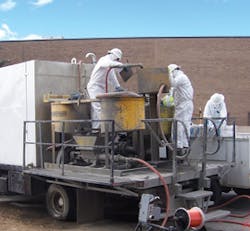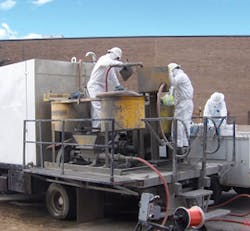When it comes to repairing aging water mains, municipalities are always on the lookout for cost-effective and less-intrusive technologies. Every repair made means more of the community’s water is making its way from the plant to the user. But every repair has a price tag.
The EPA estimates that in the last 20 years, communities across the US spent over $1 trillion to repair drinking water treatment and distribution structures and wastewater treatment and disposal systems. But with a growing population, continually aging water and wastewater infrastructure, and increasingly limited funds, it is estimated that by 2020 there will be shortfall in funding that could reach $500 billion.
With EPA’s data supporting it, and communities relying on their own experience, new technologies for improving water delivery are growing in number. But each technology must be evaluated for its effectiveness and applicability, and just how it will work in the water main repair toolbox. One Denver, CO, suburb tested a new solution and was pleased with the outcome.
Identifying the Need
The city of Thornton, CO, is just 10 miles north of Denver and home to a population of just over 117,000 residents. The city itself is about 50 years old, as is much of the infrastructure. Like any city, Thornton looks to maintain water treatment and distribution services to its residents with minimal cost and disruption. So when an alternative to standard trenching was suggested for water line repair, it garnered attention.
The project area was identified through GIS mapping. In the city of Thornton, when small leaks are identified, they are entered into a GIS database. Over time, when certain areas show up repeatedly, they are scheduled for repair. In the case of the Hoffman Way project, a section of 50-year-old asbestos-concrete pipe hit the radar time after time and was obviously in need of refurbishment.
Jason Pierce, project manager with the city of Thornton, explains that Hoffman Way was used as a pilot program to compare trenchless to open cut projects. The idea of going trenchless came about because a portion of the project involves water lines buried below old, large trees.
“We wanted to see if we could repair the pipe with minimal disruption to the neighborhood,” says Pierce.
The city put out a request for proposals and received bids from companies planning to use traditional trenching and other trenchless technologies such as horizontal directional drilling and centrifugal application to repair the stretch of pipe. W.S.U. Inc. of Breckenridge, CO, won the project, proposing to use the company’s proprietary MainSaver technology. The price came in at $140 per lineal foot for 2,000 feet of 6-inch pipe. Pierce believes it’s realistic to plan future work to come in a little higher, somewhere between $150 and $175 per lineal foot.
Harry Baum is president and owner of W.S.U. Inc. His experience in the field started literally in the trenches, doing excavation and rehabilitation work. His company has used the MainSaver technology for two years, and Baum points out that its applicability comes down to different factors, including the number of bends and valves, but none are deal breakers. The only absolute condition that can stop a project is the condition of the pipe. “We will look at the pipe, and we won’t say every reach can be lined,” says Baum. “It may not be worth it, and it might be better to have somebody dig it up and replace it.” Determining the feasibility of using Baum’s technology comes in the initial phase of project work.
Step by Step
Like other technologies, MainSaver is done through a series of consecutive steps. Typically, project execution generally takes place in eight steps. The Hoffman Way, like other projects, followed the steps listed here.
Replacing. Before any work is done on the existing water line, it must be taken out of service, and a temporary line established. The temporary pipe is connected either to a fire hydrant or the main line, within an excavated pit. The temporary line generally runs across the top of the ground and branches off, connecting to homes at individual meter pits.
New technologies for improving water delivery must be evaluated for effectiveness and applicability.
Videoing. The existing water line is examined. This requires excavations at two pipe locations. Pits are dug at the launch and receiving ends of the pipe to be inspected. The distance between launch and receiving can span upwards of 400 to 500 feet. Generally, pits are 4 feet by 6 feet across and about 4.5 feet deep to the top of the pipe.
“We TV the pipe and watch on a closed circuit,” says Baum. “We can make sure that it’s in good enough shape to rehab and locate the service laterals; we map them out so we know where they are. Then we give the owner a report.”
If it’s decided that the condition of the pipe warrants repair over replacement, the process moves on. In the case of the Hoffman Way project, the pipes were deemed salvageable, and the project moved on.
Cleaning. The pipe is then cleaned, using pressurized water or mechanical rodding. “This can take from one hour to one day to complete, depending on how dirty it is,” says Baum.
“Due to the buildup of mineral deposits on the pipe, it was determined that cleaning the pipe was necessary,” says Pierce. “The deposits can affect the grout consistency and its ability to distribute evenly around the liner.”
Testing. Depending on the type of pipe, Baum and his team then diverge from the normal lining process and test the pipe for electrical conductivity. External pipe corrosion exists when the outside of the pipe becomes the anode to the soil’s cathode, causing corrosion of the outside surface of the pipe. Any corrosion that has taken place on the outside of the pipe can’t really be repaired, but it can be held at bay. With the use of a sacrificial anode, such as zinc or magnesium, the pipe can be spared. To determine the best solution, Baum calls on geotechnical engineers to collect soil samples and recommend the most suitable anode.
Asbestos-concrete pipes are resistant to most external corrosions. In the case of the Hoffman Way project, the pipes were in good condition, meaning no external remediation or sacrificial anode was necessary.
Plugging. The service laterals must then be plugged to keep the liner and grout that will be installed from migrating out of the main line. In Thornton, W.S.U. introduced RoboTap, the first commercial use of this process, to locate and cork the laterals. The remotely operated robotic equipment travels the length of the pipe run, from launch to receiving end, plugging the laterals and documenting their location.
Lining. The lining comes in rolls 320 centimeters wide and makes its way from a plant in Barcelona to destinations in the US. The inside and outside of the tubing are vastly different. The outside is designed like Velcro, patterned with useful hooks. The inside is smooth to not impede hydraulic conductivity. The length of the liner is pulled through the pipe from launch to receiving end, going over any of the corks placed at the service laterals.
Grouting. Once the lining is in place, it must be kept in place. The liner is sealed to the host pipe by pumping grout into the 3-millimeter-wide annulus between the host pipe and the liner. The hooks on the Velcro exterior of the liner imbed themselves into the grout, creating a composite-like material.
To ensure that the grout is evenly distributed throughout the length of the pipe, a rounding swab is sent through the length of the pipe. This pushes the grout into any pinholes, cracks, and fissures. Approximately half a pound of pressure is applied using the swab, and then it is left to cure overnight. The next day, the internal of the pipe is checked using an infrared camera. The camera will pick up any gaps in the grout.
The Hoffman Way project was used as a pilot program to compare trenchless to open cut projects.
W.S.U. Inc. won the project, proposing to use the company’s proprietary MainSaver technology.
When it comes to how much grout to inject, more is better. “We use about 200% to 300% of the annulus volume,” explains Baum. “We want more grout than we think we’ll need. The extra grout goes out the end and becomes part of the backfill in the pit.”
The grout is subject to temperature and must be between 45ËšF and 55ËšF. The grout is mixed on the spot, so water temperature is critical and needs to range between 65ËšF and 75ËšF. During the summer, this might mean adding ice to the mix water. During the winter, it can be heated up using a heating iron. Admittedly, working outside through the cold winter months isn’t something Baum is fond of, but he is willing, and his technology is capable. “It’s not a deal breaker,” says Baum; “you just have to make sure it’s addressed.”
Drilling. The liner is laid through the straight length of pipe, but the homes cannot access it, as the service lines are still plugged. RoboTap then returns to drill out the corks that were installed at the service laterals. This is done by inserting a cap or sleeve into the connection.
During the Hoffman Way project, there was a slight glitch when it came to cutting through the grout. Since this was the debut of the RoboTap, it needed to be adjusted for the 6-inch pipe. “The top of the cap was too big to fit on the inner wall of the six-inch-diameter pipe,” says Pierce. “But they were resized, and the problem was resolved.”
Once it’s determined that the rehab work is complete, it usually takes another three to five days to return the pipe to service. With water lines, the pipe must be disinfected following local regulations. In Thornton, this included allowing chlorinated water to sit in the pipe, and then performing a bacteriological review.
Broad Range Applicability
The technology can be used on pipes ranging from 4–12 inches in diameter, including concrete, ductile iron, cast iron, steel, and asbestos cement. The process hasn’t been used on plastic pipe yet, because it’s relatively new to the field, and to date there hasn’t been a demand to repair plastic piping. But Baum doesn’t believe W.S.U.’s MainSaver technology will have any problems rehabbing plastic when the time comes.
All in all, the pipe inspection and rehab can be done within one week: one day to open and inspect the pipe; one day to cork the service laterals; one day to lay the liner and grout the pipe; the grout then cures for a day before the pipe’s final inspection; add to that the time to put the line back in service, and the schedule is complete.
“MainSaver is a good application for certain projects,” says Pierce. “It’s not the Holy Grail, but in certain applications it is cost-effective. The two biggest issues that impact trenchless technology is the amount of asphalt and the number of fittings.”
The process is limited in pipes with bends and cannot be used at tees. Pierce determined that for the Hoffman Way project, because there were straight lengths of pipe at least 300 feet long, MainSaver was a cost-effective alternative to traditional open trenching. “The price goes up every time you have to dig an access point,” he adds.
But the cost of excavating access points has to be compared to the amount of asphalt that will have to be trenched through and replaced. While he found his own break-even point, Pierce acknowledges that others may come up with different numbers.
As a result of going trenchless, the City of Thornton was able to save approximately 50 mature shade trees and avoid the replacement of 25 driveways. “The people paying for the work are the people living in the houses,” says Baum.
“The project was shorter and cleaner than open cut,” says Pierce.
And even with a slight delay in schedule, people were ultimately pleased with the work. “We’ve had no complaints,” adds Pierce.
Beyond improving water delivery, avoiding customer complaints is a goal for any community manager.



